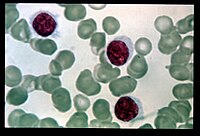
Photo from wikipedia
Background The standard pathways of testing and treatment for hepatitis C virus (HCV) infection in tertiary healthcare are not easily accessed by people who inject drugs (PWID). The aim of… Click to show full abstract
Background The standard pathways of testing and treatment for hepatitis C virus (HCV) infection in tertiary healthcare are not easily accessed by people who inject drugs (PWID). The aim of this study was to evaluate the efficacy of integrated treatment of chronic HCV infection among PWID. Methods and findings INTRO-HCV is a multicenter, randomized controlled clinical trial. Participants recruited from opioid agonist therapy (OAT) and community care clinics in Norway over 2017 to 2019 were randomly 1:1 assigned to the 2 treatment approaches. Integrated treatment was delivered by multidisciplinary teams at opioid agonist treatment clinics or community care centers (CCCs) for people with substance use disorders. This included on-site testing for HCV, liver fibrosis assessment, counseling, treatment, and posttreatment follow-up. Standard treatment was delivered in hospital outpatient clinics. Oral direct-acting antiviral (DAA) medications were administered in both arms. The study was not completely blinded. The primary outcomes were time-to-treatment initiation and sustained virologic response (SVR), defined as undetectable HCV RNA 12 weeks after treatment completion, analyzed with intention to treat, and presented as hazard ratio (HR) and odds ratio (OR) with 95% confidence intervals. Among 298 included participants, 150 were randomized to standard treatment, of which 116/150 (77%) initiated treatment, with 108/150 (72%) initiating within 1 year of referral. Among those 148 randomized to integrated care, 145/148 (98%) initiated treatment, with 141/148 (95%) initiating within 1 year of referral. The HR for the time to initiating treatment in the integrated arm was 2.2 (1.7 to 2.9) compared to standard treatment. SVR was confirmed in 123 (85% of initiated/83% of all) for integrated treatment compared to 96 (83% of initiated/64% of all) for the standard treatment (OR among treated: 1.5 [0.8 to 2.9], among all: 2.8 [1.6 to 4.8]). No severe adverse events were linked to the treatment. Conclusions Integrated treatment for HCV in PWID was superior to standard treatment in terms of time-to-treatment initiation, and subsequently, more people achieved SVR. Among those who initiated treatment, the SVR rates were comparable. Scaling up of integrated treatment models could be an important tool for elimination of HCV. Trial registration ClinicalTrials.gov.no NCT03155906
Journal Title: PLoS Medicine
Year Published: 2021
Link to full text (if available)
Share on Social Media: Sign Up to like & get
recommendations!